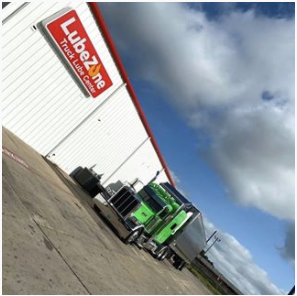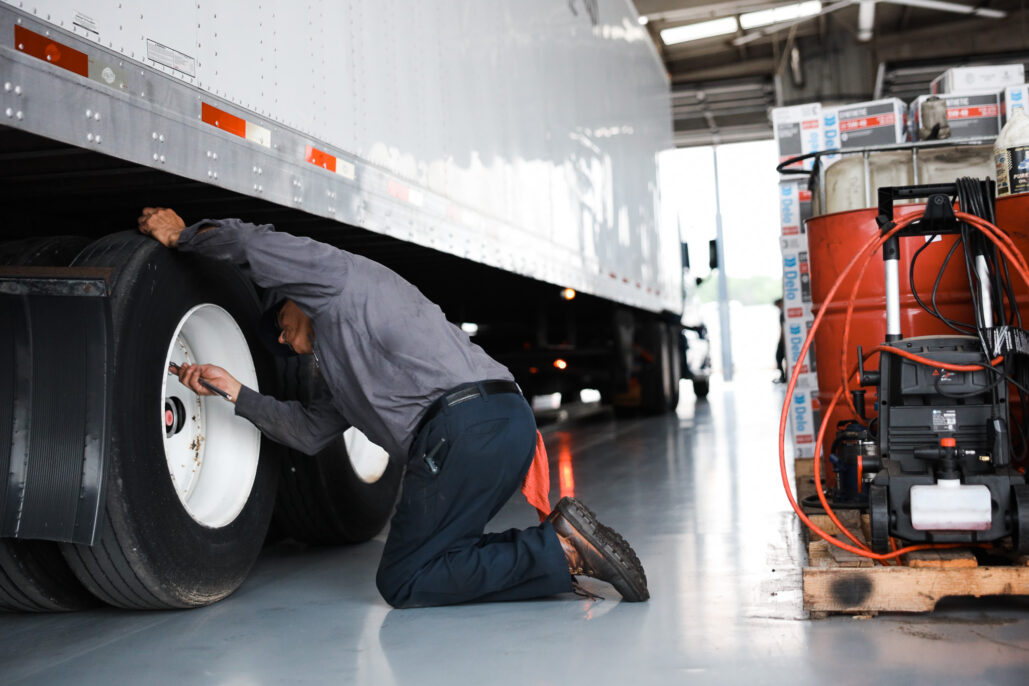
2025 CVSA Roadcheck Guide for Truckers
May 20, 2025
Semi-Truck Preventative Maintenance: Keep Your Rig Road Ready
May 30, 2025Understanding the impact of semi-truck tire pressure on fuel efficiency can help you optimize tire maintenance, reduce operating costs, improve safety, and contribute to lower carbon emissions by ensuring that trucks are running at peak performance. It helps to minimize the chance of dangerous tire blowouts on the road — one of the leading causes of semi-truck accidents in America. Additionally, it gives you better drive and steering control, ensures a smoother ride, and puts more money back in your pocket.
At LubeZone Truck Lube Centers, we offer FREE tire checks for every service and tire alignment at an additional cost. We pride ourselves on providing drivers, owner-operators, and fleet managers with the very best in truck maintenance tips, so you can keep your rigs in optimal shape. Not only does this result in a better experience for employees, customers, and other drivers, but at the end of the day, it saves you money.
Keep reading to learn more about the relationship between semi-truck tire pressure and fuel efficiency, and stop by to see us along your next route. Visit LubeZone, home to the 40-minute quick lube change, today.
How Tire Pressure Affects Fuel Efficiency
There’s a direct relationship between tire pressure and fuel consumption in semi-trucks. The proper PSI primarily impacts rolling resistance, tire wear, load distribution, and performance. According to the U.S. Department of Energy, for every 1 PSI drop in tire pressure across all tires, fuel economy decreases by approximately 0.2%. This may seem like a slight difference, but it can have a significant impact on your bottom line.
When you reduce semi-truck tire PSI to only 50% of the recommended pressure, fuel economy drops by 5-10%. These differences become most apparent at slower speeds. At 40 mph, fuel economy with all tires at 50% of their recommended PSI is about 10% lower than expected. At 80 mph, the amount is 5%.
Here’s a quick overview of the impact of semi-truck tire pressure on fuel efficiency:
- Rolling Resistance: Under-inflated tires increase rolling resistance, which means the engine has to work harder to move the truck. This requires more fuel to maintain the same speed. On the other hand, over-inflated tires can lead to a harsher ride and reduced contact with the road, which can also reduce fuel efficiency.
- Tire Wear: Improper tire pressure can cause uneven or premature tire wear. Under-inflated tires tend to wear out faster on the edges, while over-inflated tires wear out more in the center. Both types of wear can lead to less efficient fuel consumption as the truck’s tires are not performing at their best.
- Load Distribution: Proper tire pressure ensures the truck’s load is evenly distributed across all tires. If tire pressure is off, certain tires may carry more weight, resulting in inefficient fuel consumption.
- Optimal Performance: Maintaining the correct tire pressure ensures that the tires perform to their full potential, maximizing fuel efficiency. According to manufacturer recommendations, adequately inflated tires minimize energy loss and friction, helping the vehicle run more smoothly and use less fuel.
What Is the Optimal Tire Pressure for Semi-Trucks?
The optimal tire pressure for a semi-truck is generally between 85 and 120 PSI, though there are specific factors that impact these metrics. Factors like your expected maximum speed, load distribution, and driving conditions all make a difference. Additionally, tires in different positions require different PSIs.
For example, heavier loads require a higher PSI to help the tires maintain their shape and integrity. You must also increase PSI with an increase in expected speed.
- Front Drive Tires: 110 PSI
- Back Drive Tires: 95-115 PSI
- Steer Tires: 95-115 PSI
Always check your tire’s sidewall for the manufacturer’s PSI recommendation. Your manual will provide more information regarding speed and weight. Alternatively, consider using this tire pressure calculator for personalized recommendations.
Factors Affecting Tire Pressure
Various environmental, behavioral, and lifestyle factors can impact semi-truck tire pressure, including temperature, driving habits, tire age, and others.
- Hot weather causes a natural increase in PSI.
- Cold weather causes a natural decrease in PSI.
- Heavier loads can cause a decrease in PSI.
- As tires age, their ability to retain air decreases, necessitating more frequent PSI checks and adjustments.
- Aggressive driving, such as rapid acceleration, hard braking, and high-speed driving, can cause tires to heat up more quickly and alter their internal air pressure.
- Using improperly calibrated inflation equipment can result in incorrect pressure readings (PSI).
- Larger tires typically require higher PSI, while smaller tires require less.
- Increased altitude can affect PSI.
- Driving over rough or uneven roads can cause more wear on tires, leading to fluctuations in tire pressure.
Consequences of Incorrect Tire Pressure
The consequences of incorrect tire pressure are largely financial, but can also be safety-related. According to the Federal Motor Carrier Safety Administration (FMCSA), semi-truck tire blowouts are responsible for approximately 8,000 semi-truck accidents in the United States each year. This accounts for about 6% of all large truck accidents on the road.
While the average cost of a semi-truck tire replacement ranges from $400-$1,500 per tire, the true cost of a blowout accident can be much higher. When you factor in vehicle damage, property damage, and occupant injury, some tire blowout accidents end up costing $300,000 or more, according to GPSTrackIt.
Additionally, tire blowouts cost drivers and companies lost productivity, delayed schedules, and added service hours on the road. Unwanted repair costs and unexpected downtime are some of the biggest hassles truck drivers face when addressing a blowout.
However, there are more consequences to keep in mind:
- Increased cost of tire replacement due to premature wear and tear.
- Increased costs are associated with poor fuel efficiency.
- Decreased traction and poor handling.
- Reduced load-carrying capacity.
- Increased maintenance costs.
- And more.
Best Tools for Monitoring Tire Pressure In Semi-Trucks
Some modern trucks come equipped with TPMS systems — Tire Pressure Monitoring Systems. These provide drivers with updates and alerts when a tire falls outside the ideal PSI range. However, as with all computers and technology facets, this comes with the risk of malfunction and error. While these are good first-line defense tools against improper PSI, you always want to double-check the machine-learning information at your next stop.
You can also purchase tire pressure sensors for self-installation that mount directly inside the tire or valve system. Additionally, some fleet managers are shifting toward total fleet management systems, including tire pressure monitoring, as part of a larger software package that tracks the health of their trucks. One of the most popular fleet management systems currently available is Geotab Fleet Management.
However, nothing beats a manual tire check at a routine pit stop. At LubeZone Truck Lube Center, we perform free tire checks with every service. Our friendly technicians will check the PSI in each tire at your next stop and adjust the pressure for you as needed.
Tire Pressure Maintenance Tips for Truck Drivers
Tire pressure is essential for truck safety, fuel efficiency, and longevity. Maintaining the proper PSI is one of the most crucial truck maintenance tips out there — it’s a basic and fundamental aspect that can save you big time.
Here are a few truck maintenance tips for tires and PSI from the experts at LubeZone:
- Check your PSI at each stop, as well as before and after each trip, to ensure it’s within range.
- Check tire pressure when the tires are cold (before the truck is driven), as heat from driving can cause pressure to rise, leading to inaccurate readings.
- Adjust your PSI as necessary before trips based on your load weight.
- Ensure proper load distribution at all times.
- Use a high-quality tire pressure gauge.
- Follow the manufacturer’s recommendations for PSI based on your tires, weight, speed, and more.
- Keep an eye on your TPMS — if you get an alert, stop to double-check the reading as soon as possible.
- Inspect tires for visible signs of damage, punctures, or foreign objects at each stop.
- Check PSI when the weather changes. PSI typically drops 1-2 units for every 10°F decrease in temperature.
The Environmental and Cost Benefits of Proper Tire Pressure
Properly inflated semi-truck tires have a significant impact on the environment, due to their effects on fuel efficiency, tire longevity, and emissions. Maintaining the correct PSI does more than save you money–it also helps save the world around us.
Ways semi-truck tire PSI and improved fuel efficiency benefit the environment:
- Less Fuel Consumption. When you reduce rolling resistance with proper tire pressure, you consume less fuel. This directly reduces greenhouse gas emissions, including CO2.
- Longer Tire Life. When you can keep your tires longer, that means fewer end up in landfills. This also means less stress on manufacturing and production, tire transportation, and disposal.
- Less Heat Generation. Tires with improper PSI create more heat as they move over the road due to increased friction. Proper PSI leads to cooler-running trucks and less wasted energy.
- Decreased Oil Consumption. When tires are properly inflated, fuel consumption is reduced, resulting in lower oil demand. This means less impact on oil extraction, refinement, and transportation.
Maintaining the correct tire pressure in semi-trucks not only extends the life of the tires and improves fuel efficiency but also plays a critical role in reducing carbon emissions, conserving resources, and minimizing the environmental impact of industrial and commercial transportation. It’s driving that you can feel good about.
Visit LubeZone Truck Lube Center Today
Stop at LubeZone Truck Lube Center along your next route. We’re home to the famous 40-minute quick-serve oil change and all things relating to semi-truck preventive maintenance. With FREE tire checks at each stop, we’ll help you maintain optimum PSI for ultimate fuel efficiency and increased savings. Additionally, LubeZone offers light mechanic work for semi-trucks.
There’s no appointment necessary — find a LubeZone location near you today, and be sure to ask about our best truck maintenance tips!

LubeZone is the fastest growing dedicated semi-truck service in the United States with locations in Texas, California, Oklahoma, North Carolina and Georgia. Our preventative maintenance solutions are designed to get the professional driver back on the road FAST.



